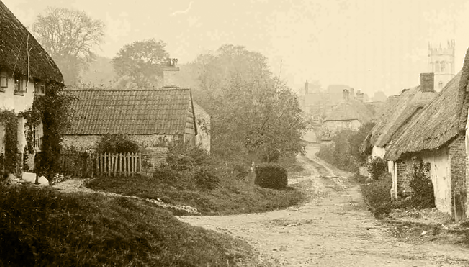






























































































































































































































































































































































































































































































































































































Piddletrenthide
On her marriage to Ethelred (The Unready) in the year 1002, Emma, the daughter of the Duke of Normandy, received land in the village of Piddletrenthide, in the valley of the River Piddle. From her Norman French connection and the area’s assessment in the Domesday Book comes the village name: piddle a stream of clear water; trent for 30; hide a measure of land. When Ethelred died, Emma promptly married King Canute and handed Piddletrenthide over to the Benedictine monastery at Winchester, which held it until the dissolution of the monasteries in the sixteenth century. It then passed into the ownership of Winchester College until the 1950s.
Piddletrenthide is a very long village and, in Saxon times, was divided into three tithings, each with its own mill. The church and manor house area is the upper tithing, another group of cottages form the middle, and the third includes the hamlet of White Lackington.
Piddletrenthide has one of the finest village churches in Dorset with a splendid 15th century tower and gruesome gargoyles under its battlements. The south doorway is Norman, so are the piers of the chancel arch. The colouring of the church exterior is one of its charms. The grey, yellow and browns in the walls contrast with the distant green of the downs.
Thomas Hardy, as an architect’s assistant, worked on the church and may have taken the name for the novel Tess of the D’Urbervilles from the graves of the Dumberfield family in the churchyard.
In 1959 Ogden Nash, the American poet and humorist, was inspired by an advert in Country Life to write a poem for The New Yorker which begins:
Had I the shillings, pounds and pence,
I’d pull up stakes and hie me hence;
I’d buy that small mixed farm in Dorset
Which has an inglenook and faucet
Kiddles Farm,
Piddletrenthide,
In the valley of the River Piddle.


Piddletrenthide recently featured in the book Burning Bright by Tracy Chevalier (most famous as the author of the book of the film Girl With A Pearl Earring):
“......Piddletrenthide was a long, narrow village, with far more than the thirty houses it had been originally named for stretched out along the Piddle for over a mile. The Crown was on the edge, just before the village became Piddlehinton. Jem was out of breath by the time he reached the pub. Once he got his breath back he asked around, but no one had seen Maggie. He knew, however, that a stranger could not get far in the valley without people noting them. At the New Inn Jem spoke to some children hanging about, who said Maggie had passed them half an hour earlier. Farther on an old man confirmed he'd seen her by the church. Jem ran on in the gathering dusk.......”

Hey diddle, hey diddle, hey diddle
I live on the banks of the Piddle
But if it should flood
There is no doubt I should
Be in piddle right up to my middle





































































































































































Call us during the day and most evenings on the following numbers:
020 8542 6839
07770 478904
07798 654053
We can also be emailed here: info@dorsetcottage.biz






































































































































































































































































































































































































































































































































































































































































































































































